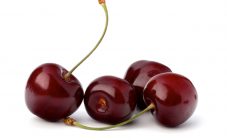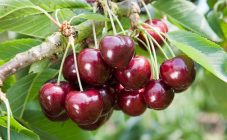Content:
Sweet cherry Melitopol was selected for a temperate continental climate. The variety was bred in Melitopol as a result of crossing the varieties Rannyaya Mark, Valery Chkalov, Zhabule, Franz Joseph, Elton.
The State Register describes 3 varieties: Melitopol early cherry (1976), Melitopol red (1996), Melitopol black (1969).
Melitopol black
The variety is recommended for cultivation in the southern regions and in the North Caucasus region. The people nicknamed the Melitopol cherry the Bird cherry, Sweet cherry because of the great love of birds for it, destroying up to 40% of the harvest.
Description
Cherry Melitopol black grows rapidly, often reaching a height of 6 m. Sprawling dense crown of a spherical contour, densely leafy, formed due to raised branches.
The foliage is serrated, and the tips are pointed. It will take only 4 years for a seedling to produce its first crop. Black cherries are well preserved and suitable for transportation. That is why Melitopol cherry was cultivated on an industrial scale.
Berries
Ripe berries are dark, almost black. All are covered with barely noticeable gray specks. In the native region, cherries ripen from mid-June. The sugar content of the fruits is more than 13%, the acidity is minimal.
Sweet cherries are large with a thin, but rather dense skin, about 8 g, but they are also found in 12 g. Ripe fruits can be on the branches for almost a month, not succumbing to rotting, without crumbling. The stalks are easily torn off without damage.
The dark red pulp is elastic, when crushed, a rich burgundy juice is released. The stone is small and can be removed without effort.
Pollination, productivity
This cherry variety is cross-pollinated. For the ovary to appear, other cherries or cherries are needed in the neighborhood. The only condition is the simultaneous flowering of trees. The best pollinators are Large-fruited, Surprise. Varietal crops of Kurortnaya, Kosmicheskaya, Black Dybera are well pollinated.
Melitopol early
This cherry variety has bright red fruits, not very large, medium. Their shape is flat-round, slightly bumpy. The juicy pulp contains white streaks. Mixed fruiting of Melitopol early sweet cherry occurs 3 years after the planting of the seedling. The first ripening of berries was noted at the end of May.
The self-fertile variety is pollinated by other cherries that bloom at the same time. The varieties Rubinovaya Rannyaya and Bigaro Burlat act as a good pollinator.
Sweet cherry Melitopol large-fruited
The large-fruited variety of Melitopol cherry is late-ripening.
The fruit tree does not exceed 3 m, which is convenient for caring for it. The rootstock easily adapts to new conditions, the description of the variety contains a note that it has good frost resistance.
The tree has a luxurious spreading crown, gray-brown bark, large oval leaves. Fragrant flowers have white petals wide open.
This late variety has very large sweet fruits (10.5-12 g) with a light heady aroma. Aromatic and healthy cherry juice is made from ripe berries.
Agricultural technology of cultivation
If the root system of the seedling is closed, then it is transplanted by transshipment at any time, if it is open, then the planting occurs during the dormant period.
Sweet cherry loves a sunny place, protected from strong winds without stagnant water. The place is chosen at a distance of 5 m from any buildings, trees, fence.
The soil
For Melitopol cherry, loamy, sandy loam soil is needed. Fertile, permeable, but most importantly light. If the soil does not meet the requirements, then it is improved: the planting hole is dug out in advance and filled with a fertile soil mixture. Suitable for planting is soil up to 50 cm deep. All other deep earth is removed from the pit.
Poor sandy soils can be enriched with old organic humus from compost manure. You can also get compost using waste from the garden, kitchen, garden.
Organic matter improves the structure of the earth, starts the movement of soil bacteria. Worms will get over from the neighbors, a perpetual organic engine will start, supplying the tree with the necessary elements, and then expensive mineral fertilizers will not be needed.
Planting a seedling
The open roots of the seedling are placed in water for a period of 2-24 hours. The trunk is cut to 60-70 cm. If the cut has dry wood, then the cut is carried out to a healthy, green color.
A peg is driven into the prepared hole closer to the northern edge. A hole is dug from the south side. The roots are straightened, and the seedling is positioned so that only the root collar is at ground level, and the scion is slightly higher.
Having sprinkled the roots with soil mixture, they lightly tamp it, form an irrigation hole around. For the first watering, you will need 1.5-2 buckets of water. Lay out mulch on top: cut grass, hay.
Tree formation
Modern gardening recommends curbing the growth of unnecessary greenery and wood. This significantly increases the yield, since all the forces of the cherry will be directed to the fruits.
The tree is formed under a Spanish bush: no more than 3 m in height.It is easier to pick berries this way, to cover it from birds. Melitopolskaya sweet cherry is very suitable for this formation.
Pruning in the first year
In the spring, the tree is cut to a level of 30 cm, but if the lower buds have died, then the level is raised to 70 cm.
In summer, from the regrown shoots, 4 upper ones are left, directed to the sides, the rest are systematically removed.
When skeletal shoots reach half a meter in length, they are cut off at the same level in a straight line. It is impossible to delay with shortening, so that the shoots of the second order grow and mature.
Pruning in the second year
The tree has a short stem, 4 skeletal branches containing 4 long shoots.
During the flowering period, the remaining shoots are cut to 30 cm.From mid-summer, the growths that appear are also pulled back to a horizontal position and the rest are cut off to 30 cm.
The Spanish bush is formed. In the future, thinning, removal of out-of-size branches, and rejuvenation are required.
Top dressing, watering
In the first year, a young seedling does not need feeding, since there is enough fertilizer in the planting pit. They begin to feed cherries from the year when they begin to bear fruit.
A young tree always needs slightly damp soil, so watering is carried out regularly. It is advisable to combine watering and feeding.
Important points of watering:
- budding period;
- the fruit reaches the size of a pea;
- shortly before frost;
- during the dry season.
Watering is carried out in an irrigation furrow, made to fit the crown circumference.
In the spring, about 300 g of urea is scattered along the furrow, and in the fall - 400 g of urea and potassium. Before freezing, the trunk circle is covered with humus, compost. In addition, every 5 years the soil is deoxidized with lime or dolomite flour.
Diseases, pests
Melitopol cherry is not afraid of moniliosis and gray rot. Petioles can dry out, turning into dried fruits, but they will not rot. Fungal viruses can only form in excessive humidity.
Untreated plants run the risk of developing cocomycosis, moniliosis. They can be attacked by a cherry fly, caterpillar, sawfly, kidney weevil, aphid.
The correct use of chemicals at different periods of the life of a cherry will reliably protect against pests.
Gluttonous birds cause great damage to the crop. There are effective ways to protect yourself:
- Wood mesh. She should wrap the whole plant, as birds easily find loopholes.
- Mulberries are planted behind the fence or on the site. The birds are more interested in it, so they will leave the cherries alone.
- Some gardeners actively use ultrasonic scarers Peregrine Falcon, Kite, or those that are designed against mice.
The use of berries is universal. They grow up to sell, for themselves, make all kinds of blanks, even freeze. Thawed cherries do not flow and retain their shape.
Advantages and disadvantages
Melitopol cherry is winter-hardy, tolerates forced drought, has excellent yield, excellent fruit taste. The berries are distinguished by their commercial qualities and dietary properties. However, the Melitopol variety also has disadvantages:
- self-infertility;
- at very low winter temperatures, many flower buds freeze out;
- spring frosts destroy most of the pistils.
For garden and backyard plots, Melitopol cherry will be the right choice if it is cultivated in a suitable area for it. With proper crown formation and decent care, there is no doubt about a huge harvest of large sweet and healthy berries.


















